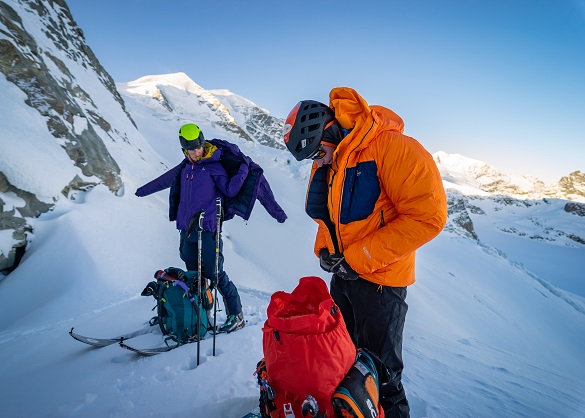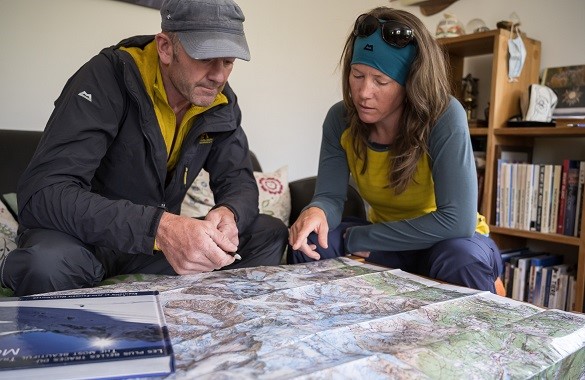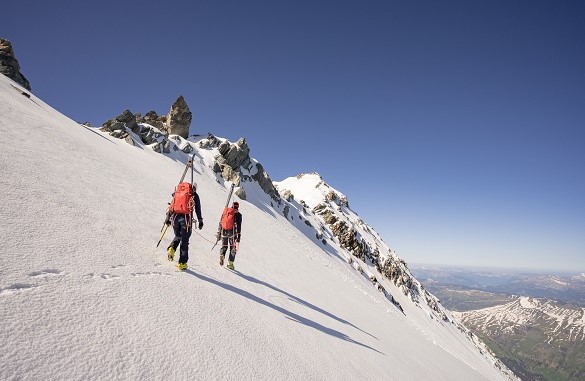Ski touring: the basics you need to know
© Silvan Metz / Mountain Equipment
Ski touring is a great way to explore the outdoors. It combines the thrill of skiing with the adventure of backcountry travel. To get started, you’ll need the right equipment and knowledge of the terrain, safety techniques, and navigation. With the right preparation, you’ll be able to enjoy the beautiful outdoors and discover new places.
What is ski touring?
Ski touring is an excellent way to get out into nature and explore the outdoors. It combines the exhilaration of skiing with the challenge of traversing whatever terrain you choose. Ski touring offers an opportunity to explore the backcountry and make your own tracks in virgin snow. It is similar to backcountry skiing, but with a few key differences. Ski touring typically involves longer distances and more elevation gain than backcountry skiing, and it usually requires the use of an overnight backpack. Another difference is that ski touring often involves route finding, or the ability to find your way through unfamiliar terrain.
There are many benefits to ski touring, but some of the most popular ones include:
- The ability to explore new terrain: ski touring gives you the opportunity to explore places that you would never be able to reach by alpine skiing alone. This means that you can discover new areas and experience different types of snow conditions.
- A workout: ski touring is a great way to get a full-body workout. Not only will you be using your legs to climb up the slopes, but you’ll also be using your arms and upper body to help with balance and stability.
- A sense of achievement: reaching the top of a difficult slope can give you an incredible sense of achievement. The feeling of accomplishment is one of the main reasons why people keep coming back to ski touring again and again.
Alpine skiing and backcountry skiing, as well as ski touring, are all ways to enjoy the slopes. However, each activity has its own set of distinct characteristics. Alpine skiing takes place on groomed pistes with marked routes, usually within a ski resort. Backcountry skiing is off-piste and involves navigating ungroomed terrain and deep powder. Ski touring is similar to backcountry skiing but involves climbing uphill using skins attached to your skis. The skins prevent you from sliding backwards so allow you to climb up slopes with relative ease. Once at the top of the hill or mountain, it’s time to ski downhill – this is when the real fun begins! All three activities can be enjoyed in spectacular mountain surroundings, but alpine skiing allows you to stay within the resort boundaries while backcountry and ski touring take you further afield into more remote areas.
Ski touring can be as difficult or as easy as you make it. It requires a lot of effort and endurance, but the rewards are worth it. There are environmental factors to take into account when ski touring, such as avalanche risks, weather conditions, and altitude. It’s important to plan your tour carefully and make sure you’re well-equipped with the necessary knowledge and gear for an enjoyable experience.

Essential gear and equipment needed for ski touring
When you are just starting out with ski touring, it is essential to have the right equipment and gear. From skis and bindings to climbing skins, boots to poles, clothing, accessories and avalanche safety gear – there is special equipment that you’ll need. Here are some basics you should consider when gearing up for ski touring.
Skis and bindings: the first essential piece of kit when it comes to ski touring is your skis and bindings. Make sure you select the right skis for the type of terrain you plan to ski on – whether that be powdery slopes or icy conditions. It’s also important to make sure your bindings are properly adjusted for your height and weight as this will ensure better control when skiing downhills.
Climbing skins: these crucial pieces of kit help to provide grip on ascents and descents, making them an essential part of any ski tour. When selecting climbing skins, make sure they fit correctly with your skis and have good adhesion for slippery surfaces.
Boots and bindings: once again, selecting the right boots for your feet is key. You’ll want something lightweight that provides support but won’t weigh you down when skinning up hills or traversing flats. You’ll also need the right binding system so that your boots fit securely in place while skiing downhill.
Poles: ski poles are a great addition to any ski touring setup as they provide balance while skiing down hills and help propel you forward on ascents. Selecting poles with adjustable handle lengths makes them easier to use in different terrain types.
Clothing and accessories: layering is an important part of any ski tour; having the right combination of thin base layers, mid-layers, insulation layers, waterproof outerwear and accessories such as hats, gloves, goggles etc., will make sure you stay warm even during the coldest days out in the mountains.
Avalanche safety gear: last but not least, avalanche safety equipment such as transceivers, shovels and probes should always be carried on any ski tour – just in case! Make sure everyone in your group has the correct safety gear before heading out into potentially hazardous terrain.
So there you have it – all the basics you need to be aware of when gearing up for ski touring! With the right equipment by your side, you’re ready to hit the slopes safely!
The perfect gear for your ski touring adventure

Planning a ski touring trip
When you’re planning a ski touring trip, there are a few things you need to keep in mind.
Choosing an appropriate location and route is important because you want to make sure you’re not getting in over your head. If you’re a beginner, it’s best to stick to lower-elevation trails and routes that aren’t too challenging. You can always work your way up to more difficult terrain as you get more experience.
Checking the weather and snow conditions is also important. You don’t want to be caught in a storm or skiing on unstable snow. Be sure to check the forecast before you head out, and pay attention to any warnings that might be issued.
Once you’ve chosen a location and route, it’s time to start planning your trip. You’ll need to map out your route, decide where you’re going to stay each night, and figure out what kind of food and supplies you’ll need. It’s also a good idea to leave a detailed itinerary with someone at home, in case of emergency.
Finally, it’s time to start packing for your trip. Here are some tips to help you make sure you have everything you need.
- Start with your basics: make sure you have enough warm clothing (including a ski jacket, gloves, and a beanie) and appropriate footwear. Pack layers of clothing so that you can adjust your outfit depending on the temperature outside.
- Don’t forget essentials: bring any medication you might need (especially if skiing at altitude) and items such as lip balm with SPF, sunscreen, and a head torch for night skiing. Also, remember to pack snacks for energy and water to keep hydrated.
- Invest in backcountry equipment: if you plan on venturing off the piste, bring backcountry safety gear such as an avalanche transceiver, shovel, and probe for avalanche rescue. This is essential for your safety in the mountains.
- Think about convenience: invest in a ski touring backpack that has enough room for all your gear but isn’t too heavy or bulky when loaded up with supplies. It should also be comfortable enough to wear while skiing or snowboarding all day long!
Packing may not always be fun, but it is important – especially if you’re going on a ski tour! Make sure you have all the right gear and equipment before setting out on your adventure so that nothing can stand between you and a successful ski tour experience.
So there you have it – a few tips for planning a successful ski touring trip. Just remember to do your research, plan ahead, and pack wisely, and you’ll be sure to have a great time out on the slopes!
There are many great places for ski touring in Europe, but some factors to consider when choosing a destination include the quality of the snow, the difficulty of the terrain, and the proximity to other ski areas. Here are six of the best places to go ski touring in Europe:
- Zermatt, Switzerland: this classic Swiss resort has some of the best skiing in Europe, with a huge variety of terrain to explore.
- Chamonix, France: another legendary skiing destination, Chamonix has some of the most challenging terrain in the Alps.
- Saalbach-Hinterglemm, Austria: this resort is known for its great powder skiing, and there are plenty of backcountry routes to explore.
- Engelberg, Switzerland: this picturesque resort is surrounded by beautiful mountain scenery and has excellent skiing.
- Livigno, Italy: Livigno is a great place for beginner and intermediate skiers, with plenty of easy off-piste skiing to enjoy.
- Val d’Isère, France: this world-famous resort has something for everyone, from beginners to experts.
Developing proper technique
Now that you’re more comfortable with the basic concepts of ski touring, it’s time to start thinking about proper technique. This is especially important if you’re planning on doing any backcountry skiing. Proper technique can make your trip safer and more enjoyable, so it’s worth taking the time to learn.
There are a few basic techniques you need to learn in order to skin uphill properly. The first is how to use your ski poles effectively. When skinning uphill, you want to keep your arms close to your body and use your poles as leverage. Make sure to place your weight on your downhill ski and not lean forward too much.
Another important technique is the kick-turn. This is when you turn from moving forward to moving backwards. To do this, plant your downhill ski pole and push off with your other ski pole. Once you’ve made the turn, continue moving forward with the same ski pole that you used for planting. Side-stepping is another useful technique for skiing on rough terrain.
Side-stepping involves stepping sideways from one depression or bump to the next in order to avoid getting stuck or losing balance. Side-stepping can be a bit tricky at first, but with practice, you’ll get the hang of it quickly!
Downhill skiing is another important aspect of ski touring. Like any sport, proper technique is key in order to avoid injury and increase efficiency. When downhill skiing, it’s important to keep your head up and look ahead so that you can anticipate changes in terrain and adjust accordingly. Keep your knees bent and lean into turns – not too far that you fall over, but enough that you maintain control of your body position.
Navigation and route-finding are also important skills to develop when ski touring. Always carry a map and a compass or GPS device with you and know how to use them before heading out into the backcountry. If you’re not sure where you’re going, it’s always best to hire a guide or join a group tour.
Lastly, remember to enjoy the view and take in all the beauty around you!

Safety considerations for ski touring
There are many safety considerations beginners need to keep in mind when planning a ski touring trip. Although it can be easy to get carried away with the excitement of the adventure, it is important that you take time to ensure that you and your group are aware of the potential dangers and have all the necessary safety gear. Here are five tips for staying safe while ski touring:
1. Avalanche safety and awareness: before heading out on your ski touring trip, make sure you understand avalanche safety basics and have an avalanche awareness course. Understand how to assess snow conditions and be aware of the steps you need to take if caught in an avalanche. Have emergency equipment such as a beacon, shovel, probe and airbag ready in case of an emergency.
2. Emergency preparedness: being prepared for any emergency situation is essential when going out on a ski touring expedition. Make sure each member of your group knows what to do in case of an injury or emergency situation by discussing a plan ahead of time and having an evacuation plan in place.
3. Travelling in a group: always stay together as a group when skiing or going out on a tour so that everyone is accounted for and no one gets left behind or lost. This ensures that everyone has somebody with them who knows what they’re doing and can help if needed.
4. Group communication & decision-making: good communication is key when travelling as a group, especially when tackling challenging terrain or making decisions about route changes due to weather or other factors. Make sure everyone understands what their responsibilities are within the group and ensure each person has the opportunity to contribute their opinion before making decisions together as a team.
5. Proper use of safety gear: finally, make sure everyone has the proper safety gear for the terrain they’ll be skiing such as transceivers, shovels, probes, airbags etc., and that they know how to use it correctly if needed in an emergency situation. By following these simple tips, you can ensure that your next ski touring trip will be an enjoyable experience filled with fun memories rather than potential danger!
Joining a ski touring course is an excellent way to start your journey as a beginner. A course can provide you with the basic skills and knowledge needed to safely participate in ski touring. Additionally, it can be very helpful to have an experienced instructor on hand to offer advice and guidance.
If you are keen on trying ski touring but don’t know where to start, we would recommend finding a guided tour. This is an activity that is led by an experienced individual and gives you the opportunity to see if this type of skiing is for you. Not only will they be able to teach you the basics, but it’s also a great way to make new friends who share the same interests as you. Guided tours are offered by many different companies, so do some research and see what options are available.
Environmental considerations for ski touring
In addition to the general considerations for all backcountry travellers (leave no trace principles, respect for wildlife and natural habitats), there are a few things that are particularly important to think about when ski touring.
First, because you’re going to be spending a lot of time off-trail, it’s important to have an extra special awareness of your surroundings and make sure you’re not damaging delicate alpine ecosystems. Second, because you’ll be packing out all your own gear, be sure to use eco-friendly products as much as possible and pack out all your trash. And finally, please be considerate of other skiers – yield to downhill traffic, avoid making too much noise in wilderness areas and stick to established trails whenever possible.
By following these simple guidelines, we can all help protect the places we love to play!
Conclusion
Ski touring is an incredible way to explore the outdoors, get some exercise, and appreciate the beauty of nature. Knowing the basics of ski touring is essential for ensuring your safety and making the most of your experience. If you’re just getting started, the key things you need to know include the different types of ski touring equipment, techniques for ascending and descending slopes, and essential safety tips. With the right knowledge, ski touring can be one of the most rewarding outdoor activities you’ll ever do. So don’t hesitate – get out there and get acquainted with ski touring!
